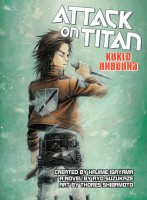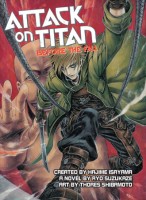 Author: Ryo Suzukaze
Author: Ryo Suzukaze
Illustrator: Thores Shibamoto
Translator: Ko Ransom
U.S. publisher: Vertical
ISBN: 9781939130877
Released: May 2015
Original release: 2012
Between 2011 and 2012, three light novels written by Ryo Suzukaze and illustrated by Thores Shibamoto were released in Japan, forming a prequel trilogy to Hajime Isayama’s massively popular manga series Attack on Titan. All three novels were translated into English by Ko Ransom and published by Vertical. The first novel was released as Attack on Titan: Before the Fall, which is the title that the entire trilogy is known by in Japan. The second and third novels, originally published in 2012, were released together in English as an omnibus in 2015 called Attack on Titan: Kuklo Unbound. The manga series Attack on Titan: Before the Fall adapts the same story found in Kuklo Unbound. I’ve been reading the Before the Fall manga and I enjoyed the first Before the Fall novel well enough, so I was interested in reading Kuklo Unbound as well.
Roaming the earth in search of humans to feast upon are the Titans–giant, monstrous creatures of mysterious origins which nobody completely understands. In order to protect itself, humanity literally walled itself off from the outside world. The Titans are nearly invincible and very few people manage to live through a direct encounter with them, but Kuklo is one such survivor. Swallowed whole by a Titan while still in his mother’s womb, against all odds Kuklo was somehow saved. However, he has never been able to completely rid himself of the stigma of being born the “son” of a Titan. Feared and hated during a time when very few people have actually even seen a Titan, Kuklo is an orphan who is abused, held captive, and treated as a sideshow oddity. As he grows older he desires nothing more than to escape his cruel fate and to prove to himself and others that he is indeed human. And though his birth was ill-omened, Kuklo may in fact be the key needed to unlock humanity’s full potential in the fight against the Titans.
 Since I have been reading the ongoing Before the Fall manga series, I was already familiar with a fair amount of the story of Kuklo Unbound and wasn’t especially surprised by any of the developments. I do think that out of the two versions the original novels are the stronger, though. The manga doesn’t always capture the internal thoughts and feelings of the characters very well, and that perspective is very important to understanding Kuklo Unbound. I feel that Kuklo Unbound is better written than the first Before the Fall novel, too, or at least it was overall more enjoyable to read. Parts of Kuklo Unbound did feel very repetitive–there was a tendency to restate obvious and well-established plot points and even use the exact same descriptions over and over again–but for the most part the pace of the narrative is quick enough that the redundancy wasn’t too frustrating. As a whole, many of the characters in Kuklo Unbound seemed to be slightly better-developed and less reliant on worn tropes when compared to those of Before the Fall, too.
Since I have been reading the ongoing Before the Fall manga series, I was already familiar with a fair amount of the story of Kuklo Unbound and wasn’t especially surprised by any of the developments. I do think that out of the two versions the original novels are the stronger, though. The manga doesn’t always capture the internal thoughts and feelings of the characters very well, and that perspective is very important to understanding Kuklo Unbound. I feel that Kuklo Unbound is better written than the first Before the Fall novel, too, or at least it was overall more enjoyable to read. Parts of Kuklo Unbound did feel very repetitive–there was a tendency to restate obvious and well-established plot points and even use the exact same descriptions over and over again–but for the most part the pace of the narrative is quick enough that the redundancy wasn’t too frustrating. As a whole, many of the characters in Kuklo Unbound seemed to be slightly better-developed and less reliant on worn tropes when compared to those of Before the Fall, too.
Kuklo Unbound works well as an omnibus, telling Kuklo’s entire story, but the two novels contained are distinct in their focus. In the first novel, Kuklo is the undisputed star. In the second novel attention is still primarily turned towards Kuklo, but by that point in the trilogy the story is really about the Vertical Maneuvering Equipment, the most recognizable technological innovation to be found in Attack on Titan. The predecessor of the Vertical Maneuvering Equipment was created in the Before the Fall novel, so this ties the prequel together quite nicely. While being different from most other Attack on Titan stories, the prequel trilogy also feels familiar, incorporating the types of scenes that have been seen before, including deadly battles with Titans, political intrigue and religious turmoil, and intense military training sequences. What makes Before the Fall and Kuklo Unbound particularly interesting is that they serve as an origin story, showing not only the development and implementation of the Vertical Maneuvering Equipment, but also the beginnings of the Survey Corps when it was still celebrated instead of despised.

